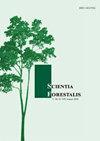Propriedades da madeira como potenciais biomarcadores de tolerância a distúrbios fisiológicos: comparação de genótipos de eucalipto divergentes
IF 0.4
4区 农林科学
Q4 FORESTRY
引用次数: 1
Abstract
Eucalypt Physiological disorder (PD) is characterized by symptoms such as bark cracking, loss of apical dominance, adventitious shoot emission, leaf abscission, among others. The use of wood biomarkers easily measurable can contribute as a criterion for the selection of tolerant clones. The objective of this study was to evaluate the wood and bark properties of commercial Eucalyptus clones tolerant and susceptible to the PD and to identify profiles of wood and bark responses related to the disorder. Three trees per clone were sampled at 3 positions along the trunk: DBH (diameter at breast height), 50 and 75%. The wood properties evaluated were wood and bark density, heartwood, sapwood and bark percentages, and wood chemical composition (extractives, lignin, syringyl/guaiacil, holocellulose, and ash). Although there were different values of bark density between the clones and their PD susceptibility classification, the averages were statistically similar. Despite the difference of wood density and extractive content, there were no trends in relation to clone susceptibility or phenotype tolerance. In general, tolerant clones showed higher growth, aboveground biomass, heartwood percentage and syringyl/guaiacil ratio, and lower bark content. These characteristics are indicated as potential biomarkers related to physiological disorder tolerance.木材特性作为抗生理障碍的潜在生物标志物:不同桉树基因型的比较
桉树生理障碍(PD)的特征是树皮开裂、顶端优势丧失、不定芽释放、叶子脱落等症状。使用易于测量的木材生物标志物可以作为选择耐受性无性系的标准。本研究的目的是评估耐PD和敏感的商业桉树无性系的木材和树皮特性,并确定与该疾病相关的木材和树皮反应概况。每个无性系在树干上3个位置取样3棵:胸径、胸径50%和75%。木材的性能评估是木材和树皮的密度,心材,边材和树皮的百分比,以及木材的化学成分(提取物,木质素,丁香基/愈创木酸,全新纤维素和灰分)。虽然不同无性系间树皮密度和PD敏感性分类值不同,但平均值具有统计学上的相似性。尽管木材密度和提取物含量存在差异,但在无性系敏感性和表型耐受性方面没有变化趋势。总体而言,耐受性无性系的生长量、地上生物量、心材率和丁香基/愈创木酸比均较高,树皮含量较低。这些特征被认为是与生理障碍耐受性相关的潜在生物标志物。
本文章由计算机程序翻译,如有差异,请以英文原文为准。
求助全文
约1分钟内获得全文
求助全文
来源期刊

Scientia Forestalis
Agricultural and Biological Sciences-Forestry
CiteScore
1.00
自引率
0.00%
发文量
39
期刊介绍:
Scientia Forestalis is a scientific publication of the IPEF – Institute of Forest Research and Studies, founded in 1968, as a nonprofit institution, in agreement with the LCF – Department of Forest Sciences of the ESALQ – Luiz de Queiroz College of Agriculture of the USP – São Paulo University. Scientia Forestalis, affiliated to the ABEC – Brazilian Association of Scientific Publishers, publishes four issues per year of original papers related to the several fields of the Forest Sciences.
The Editorial Board is composed by the Editor, the Scientific Editors (evaluating the manuscript), and the Associated Editors (helping on the decision of acceptation or not of the manuscript, analyzed by the Peer-Reviewers.
 求助内容:
求助内容: 应助结果提醒方式:
应助结果提醒方式:


